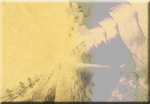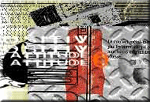|
|
|||
|
When I showed Pianographique to my friend Cliff Syringe, it blew his mind. Pianographique makes musicians wet themselves. Cliff is an electric bass player, vocalist, and painter. Lamarque also combines his musical interests with being a painter. Cliff's gold tooth gleamed and he hunkered down into playing it with the fascination that musicians reserve for instruments. Pianographique is Jean-Luc Lamarque's widely celebrated and enjoyed online interactive visual music instrument that you play with the keyboard (and sometimes the mouse also). You don't have to be a musican to play it, but it helps. I suspect that Pianographique is particularly attractive to musicians. There is variety in Pianographique along several axes. Different modules, some of which are pictured on the left, have different keyboard controls, though they all use the letters on the keyboard for the main action. For instance, the "Krsh_Neige" module allows use of the arrow keys and the numeric pad, whereas most of the other modules don't. These are for zoom in/out and color changing. Some sounds continue and others play just once. So you can set up a backbeat or a background sound and then improvise with the sounds that don't repeat, and then change background sounds. Also, the keyboard response time is good, as we need it to be. Also, there is variety in the modules themselves. Not only musical variety. Some modules are devoted to the spoken word, others are musical, others are not so much 'musical' as experimental sound or atmospheric sound. Pianographique is among a handful of notable interactive audio works on the Web, at the moment, that combine the visual and the sonic with interesting compositional possibilities. Many of these works are either interesting as works of art or interesting as instruments but not both. Though Lamarque is quite humble about his creation, Pianographique, it seems to me, is interesting both as a tool or instrument and as a work of art. It seems that there is indeed a tension between the idea of a tool or instrument and the idea of a work of art. Intriguing works do not so much 'resolve' this tension as play on it productively. Lamarque could easily make the modules capable of much more sonic diversity, for instance, make them more complex to use as instruments, give them far greater musical range, but he hasn't (yet, anyway). That would detract, unless done carefully, from the thing as a work of art approachable by more or less anybody not so much as only an instrument but a vision/audition of the direction of visual music on and offline. Note that the sound is the foreground in this piece. It's visual also, but the sound is the foreground. It is more a musical instrument than a visual instrument, though of course it is both. The sound programming is also a bit more developed than the visual programming, perhaps. The synchronization of the sound is not too bad, though simple, perhaps necessarily, since you play it like an instrument, and the synchronization depends on you—as well as the tempo of the recordings themselves. Most of the graphics are static, though in the "Sudden Stories" collaboration with Clauss and Birgé we are starting to see animations. Of course it is possible to synch the visuals and the sound, but this is not part of Pianographique yet, though who knows what Lamarque will add in the future. The "pianoscripter" he mentions in the interview sounds interesting. It will save configuration information, I surmise, not the actual sounds, to the harddrive. The interview, below, with Lamarque indicates someone who has a rather humble perspective on his creation, which has been widely celebrated. This is charming and unusual. He does not regard it so much as a work of art as "an open work", ie, presumably something open-ended to art and development as an instrument. It's this open-endedness that he carefully fosters in the work. And you can tell that he is very interested in what other people do with Pianographique—that is his focus, making it both interesting in itself but mostly a creative tool for others. He takes the 'instrumentality' of Pianographique very seriously and I expect we will see it develop fruitfully beyond its current state, which already is somewhat noteworthy. It will be interesting to see if these developments make it any more interesting as a work of art or instrument or both or something else.
|
|||
| Interview | |||
|
Andrews
|
I have visited your Pianographique many times, Jean-Luc. Is it a kind of musical instrument? | ||
|
Lamarque
|
It’ s a multimedia instrument. Just like a pianist, you have to practice and learn your score in order to play and have fun. | ||
|
Andrews
|
But it is also a work of art, it seems to me. Do you think it is as good an instrument as it is a work of art? | ||
|
Lamarque
|
Each piano is an in-progress environment in which users can play. Though each piano is conceived with an artistic aim, i see it more as an open work rather than a work of art. | ||
|
Andrews
|
Are there any important differences between instruments and works of art? | ||
|
Lamarque
|
The instrument belong to the artistic process. When the instrument is mastered it fades away and the work of art emerges. | ||
|
Andrews
|
Are there any important differences between tools and works of art? | ||
|
Lamarque
|
Tools just like instruments are creation means. | ||
|
Andrews
|
Is there a tension between the idea of a tool and the idea of a work of art? | ||
|
Lamarque
|
The original idea of the pianographique was to mix various graphic and sounds style. Though it is a myth i still dream about a magic tool or a process that would generate works of art. | ||
|
Andrews
|
Have you found yourself before in a situation where, if you wanted to make it a better tool, it would make it less outstanding a work of art? | ||
|
Lamarque
|
Of course i always want to add new features to pianos. But i do it gradually to avoid complexity, i want to keep that fresh sensitive feeling. | ||
|
Andrews
|
Do you see yourself working out new forms of music? How would you describe these, if so? | ||
|
Lamarque
|
My goal is more to create graphics and sounds that feed each other and see how the user will appropriate this. | ||
|
Andrews
|
Does Pianographique have relation to the "music video"? | ||
|
Lamarque
|
When i created the pianographique in 1992, i was very influenced by Dada, surealists, collage techniques and experimental movie makers like Oscar Fischinger who worked on the synesthesic relation of sound and image. | ||
|
Andrews
|
Are you able to make money with Pianographique? I note that you make custom versions of it. Have you been commissioned by musicians to make versions for them? | ||
|
Lamarque
|
We did pianos for The Beatles website (comissioned by EMI) and for a " french touch " band Bosco (comissioned by the musicans who enjoyed the pianographique website). In France, the web is unfortunately considered as a tool of promotion and not as an innovation and/or experimental playground. | ||
|
Andrews
|
I see that recently you have added some work by Nicolas Clauss to the Pianographique work. How did that go? | ||
|
Lamarque
|
Nicolas sent me an email to collaborate. Since we are/were both painters, the collab was easy. I did the piano engine , Nicolas created the visuals and Jean-Jacques Birgé the sounds. I enjoyed a lot this collaboration. When an artist has already his own universe, the piano is an open and ludic interpretation of his work. That was also the case with Xavier Pehuet (http://seelans.net) who has been working with me for 2 years and did the "Angular Entropy" and "krsh_neige" pianos. | ||
|
Andrews
|
Have you worked with servovalve? If so, what did you do together? Have you worked with Schmitt or Durieu? Do you share interests with them? What are they? | ||
|
Lamarque
|
I collaborated with servovalve for the Jean Tinguely CD-Rom. And we meet from time to time when we showcase. I worked with Durieu for an educational CD-rom for kids. We share this desire to explore new forms, each of us in our specific way. | ||
|
Andrews
|
Are you involved in performance with Pianographique? What sort of venues, if so, and how are the performances? | ||
|
Lamarque
|
Since many people have contributed to the pianographique’s adventure when we perform there is more than one interpretation. There is always a camera shooting the keyboard so the audience can understand what is going on. Thus people can realize that interpretation is a very important notion in the pianographique’s creative process. | ||
|
Andrews
|
What are you working on now, and what do you want to do in the future? | ||
|
Lamarque
|
There will be new collabs with graphists and musicians that enjoy pianographique. There are also new tools in progress: The "pianomixer" that will allow to create your own piano by picking up elements in a database of graphics and sounds The "pianoscripter" that will generate and edit scores. | ||
|
|||




